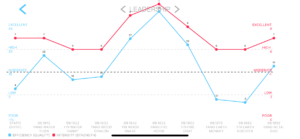Candace Owens has been in the crossfire lately. First, it was the controversial claims regarding…
Robert E. Lee – The Military Genius
Robert E. Lee is widely regarded as one of the most capable American Civil War military commanders, primarily for his strategic brilliance, deep understanding of battlefield tactics, and remarkable ability to inspire his troops.
Lee’s military genius is recognized for his innovations in defensive tactics, his aggressive and often unpredictable offensives, and his ability to inspire and lead under dire circumstances. While his legacy is complex due to his role in the Confederacy, Lee’s tactical brilliance remains a key subject of study in military history, illustrating both the effectiveness and the limits of leadership and strategy in warfare.
 Robert E. Lee was born on a Yang Wood Day, an Element often associated with strong principles, resilience, and a natural tendency toward leadership. His Yang Wood Day Master, however, is relatively weak, though without knowing his exact birth hour, we can’t determine its precise strength. Nevertheless, in some cases, the strength of the Day Master is less crucial if the BaZi Chart structure allows effective utilization of surrounding elements, and Lee’s Chart exemplifies this.
Robert E. Lee was born on a Yang Wood Day, an Element often associated with strong principles, resilience, and a natural tendency toward leadership. His Yang Wood Day Master, however, is relatively weak, though without knowing his exact birth hour, we can’t determine its precise strength. Nevertheless, in some cases, the strength of the Day Master is less crucial if the BaZi Chart structure allows effective utilization of surrounding elements, and Lee’s Chart exemplifies this.
Dynamic Interplay Between Fire and Metal
One of the key features of Lee’s BaZi Chart is the presence of a Yang Fire/Tiger pillar. This strong Fire Element has a natural tendency to “obtain” Metal from other pillars, such as the Month and Day pillars, forming a powerful and harmonious interplay. This kind of dynamic—where an Element from the right side of the Chart obtains or seeks an Element from the left side—is particularly advantageous, as it creates a robust, well-utilized structure. This synergy between Fire and Metal is ideal because it supports a unique Leadership Talent Bridge, a configuration that reflects Lee’s commanding presence and leadership aptitude.
The Fire and Metal elements in Lee’s Chart do more than merely coexist; they engage in a productive combination. Yang Fire at the top represents artistic, strategic, and visionary qualities, whereas Yin Metal, also present at the top of the Chart, embodies political influence and fame. These two elements combine in a way that effectively doubles the impact of the Leadership Talent Bridge, demonstrating not only command of tactical decisions but also a heightened ability to inspire and direct others. The Yang Wood Day Master, although weak, has access to this dynamic by “producing” Fire in the stems, meaning it directly contributes to the powerful Fire-Metal interplay. Consequently, the strength of Yang Wood in Lee’s case is less relevant because it is efficiently channeled into this strategic Leadership Bridge.
Yang Fire as Strategy and Yin Metal as Power
Yang Fire represents the Artist Talent—known for keen strategic vision, originality, and creativity. This quality, coupled with Yin Metal’s political influence and renown, suggests that Lee possessed an innate talent for strategic command, not only on the battlefield but also in the broader social and political landscape. His strategic approach during the Civil War demonstrated remarkable insight and adaptability, characteristics enhanced by the Yang Fire’s ability to envision complex maneuvers and the Yin Metal’s reputation for authority. In this way, the Leadership Talent Bridge in Lee’s Chart doesn’t merely indicate tactical skill but also highlights his role as a respected authority and source of influence.
The Influence of the Yin Fire/Goat Phase During the Civil War
During the American Civil War, Lee was in the Yin Fire/Goat (Wei) phase, further amplifying the Fire versus Metal dynamic. This period brought out the full potential of his Leadership Talent Bridge by providing additional Fire energy to balance and activate the Metal elements in his Chart. The presence of Yin Fire in his Luck Pillar added a softer, yet potent, dynamic to his Chart. Yin Fire is known for its subtlety and precision, qualities that, combined with Metal, could contribute to Lee’s sense of timing and tactical finesse on the battlefield.
In practical terms, this period reinforced Lee’s ability to use his Leadership Talent Bridge to its fullest potential, informing his command decisions and tactical creativity. The Fire-Metal interplay was at its height, enabling him to respond swiftly to shifting conditions and inspire his troops even under challenging circumstances.
Analyzing the Talent Bridge: 1842–1872 Spike in Leadership Dynamics
Dynamic Talent Bridge Chart shows a strong activation of the Fire-Metal Leadership Talent Bridge between 1842 and 1872. This period aligns closely with his military career, especially during the Civil War. This peak period reflects a phase in which his Leadership Talent Bridge was not only in play but also at its most effective, amplifying his strategic acumen, charisma, and impact on others. During this period, his Chart’s balanced Fire and Metal elements would have conferred both the decisiveness of a natural leader and the adaptability required to navigate the complexities of war.

Dynamic Talent Bridge charts are available on our BaZi Hero Android and iOS apps.
Conclusion
In summary, Robert E. Lee’s BaZi Chart demonstrates a unique balance where the Leadership Talent Bridge, formed by the dynamic relationship between Fire and Metal, provided him with the charisma, authority, and tactical ability that defined his military career. His Yang Fire Artist Talent offered him a visionary approach to strategy, while Yin Metal symbolized his capacity for leadership and influence. Together, these elements enabled Lee to harness his full potential, making him one of history’s most renowned military figures. Despite the relative weakness of his Yang Wood Day Master, the Chart’s overall structure was effectively utilized, enabling Lee to excel in his role and make an indelible mark on military history.




